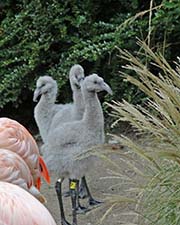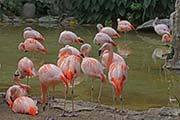Juvenile

10/10/2013 - Woodland Park Zoo, Seattle, WA
10/10/2013 - Woodland Park Zoo, Seattle, WA
|

10/10/2013 - Woodland Park Zoo, Seattle, WA
10/10/2013 - Woodland Park Zoo, Seattle, WA
|
|
Adult

02/22/2012 - Phoenix Zoo, AZ
02/22/2012 - Phoenix Zoo, AZ
|

02/22/2012 - Phoenix Zoo, AZ
02/22/2012 - Phoenix Zoo, AZ
|

02/22/2012 - Phoenix Zoo, AZ
02/22/2012 - Phoenix Zoo, AZ
|

04/15/2012 - Houston Zoo, Texas
04/15/2012 - Houston Zoo, Texas
|

11/14/2012 - Tracy Aviary, Salt Lake City, Utah
11/14/2012 - Tracy Aviary, Salt Lake City, Utah
|

10/09/2013 - Woodland Park Zoo, Seattle, WA
10/09/2013 - Woodland Park Zoo, Seattle, WA
|
Diet:
Flamingos have very long legs and they are able to search for
food in deep water.
Flamingos eat by using their feet to stir up mud and then sucking
in this mud and water through their bill and out the sides.
Briny plates in their mouth filter out aquatic insects,
larvae algae, small fishes, crustacean.
The carotenoid pigments found in the food they eat gives them
the pink plumage.
Courtship:
Chilean Flamingos reach sexual maturity at 6 years of age.
Their usually have a different partner each mating season.
During April and May, Chilean Flamingos have elaborate courtship
rituals that consist
of synchronized dancing, preening, neck stretching, honking which
both sexes perform.
Nesting:
Like the Greater Flamingo and Caribbean Flamingo, the nest is a
simple mud mound.
The parents build the nest by using their feet and bill to scrape the
mud into a mound.
Both parents incubate the one egg laid and when it hatches,
they both feed the chick crop milk
that is produced by a gland in the parents' upper digestive tract.
This bright red liquid is nutritionally similar to mammalian milk.
Habitat and Range:
Chilean Flamingos live in muddy, shallow lakes in across most of South America.
They are found from sea level to altitudes of 14,760 feet.
Vocalization:
Includes deep honking sounds, grunting and howling.
Plumage/Molt:
No alternate plumage.
Migration:
Flamingos don't normally migrate, but will if their habitat degrades.
For example, if their lake freezes or there is a drought.
When they do migrate, they tend to migrate at night and fly at high altitudes.
When they fly, Flamingos need space to take off.
They need to run far enough to generate the lift need to take off.
Tongue/feet:
Chilean Flamingos tongue is covered with bristle-like projects that help filter
water and food particles through special structures in their bill.
Bibliography:
- http://en.wikipedia.org The Free Encyclopedia, Accessed June 2012
- http://www.sandiegozoo.org/animalbytes/ San Diego Zoo, Accessed June 2012
- http://www.theanimalfiles.com The Animal files.com, Accessed June 2012
- http://rosamondgifford.org/birds Rosamond Gifford Zoo, Accessed June 2012
- http://www.birds.cornell.edu The Cornell Lab of Ornithology, Accessed June 2012
Top of Page







